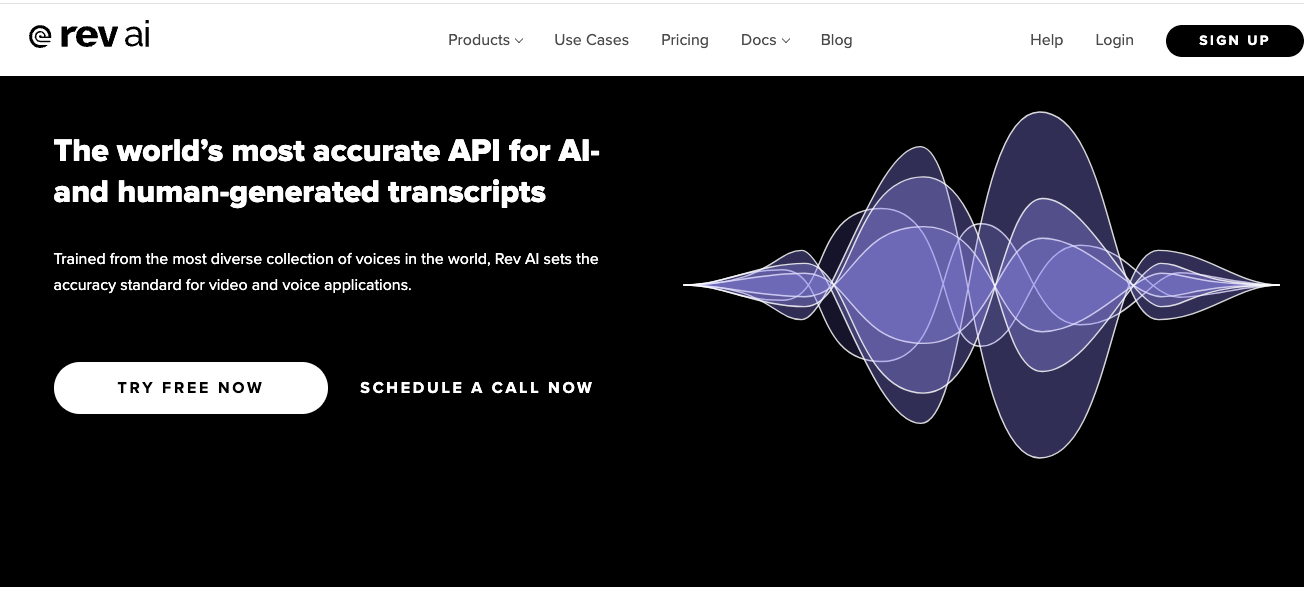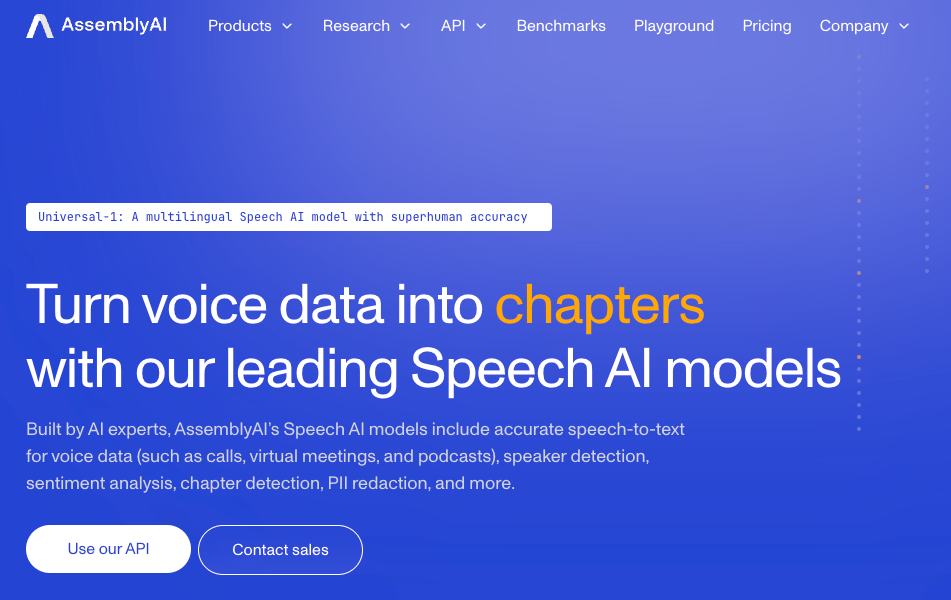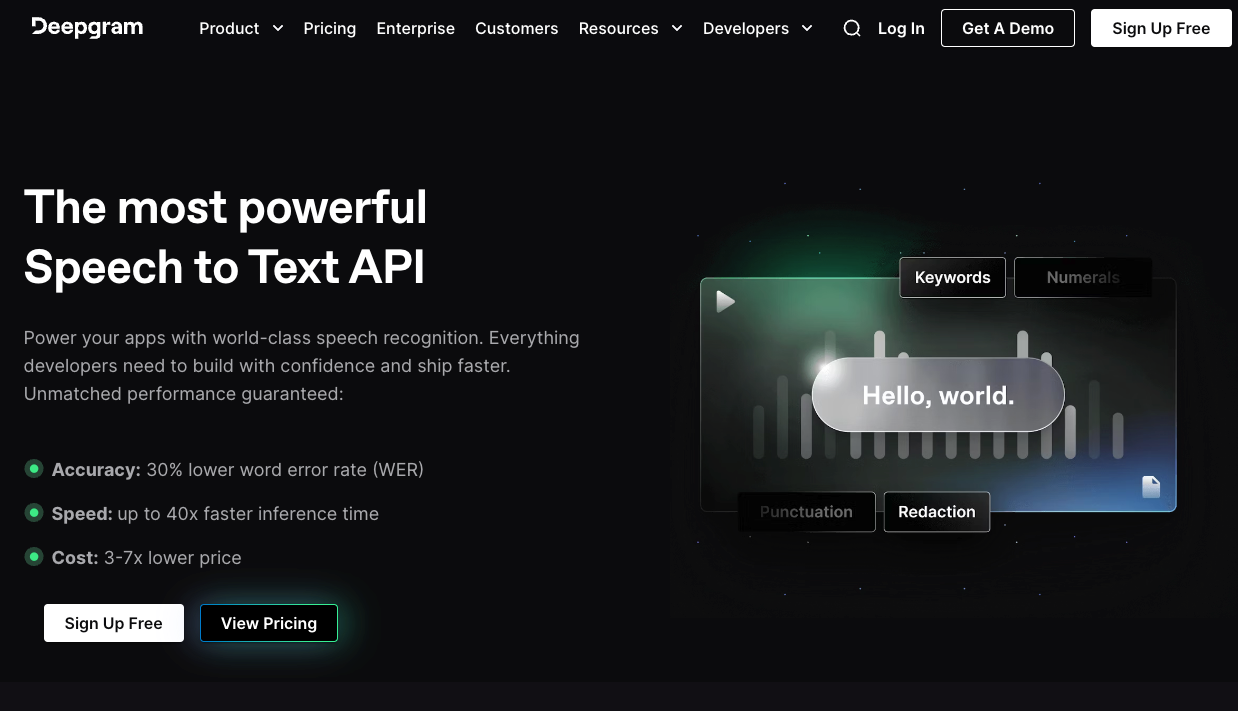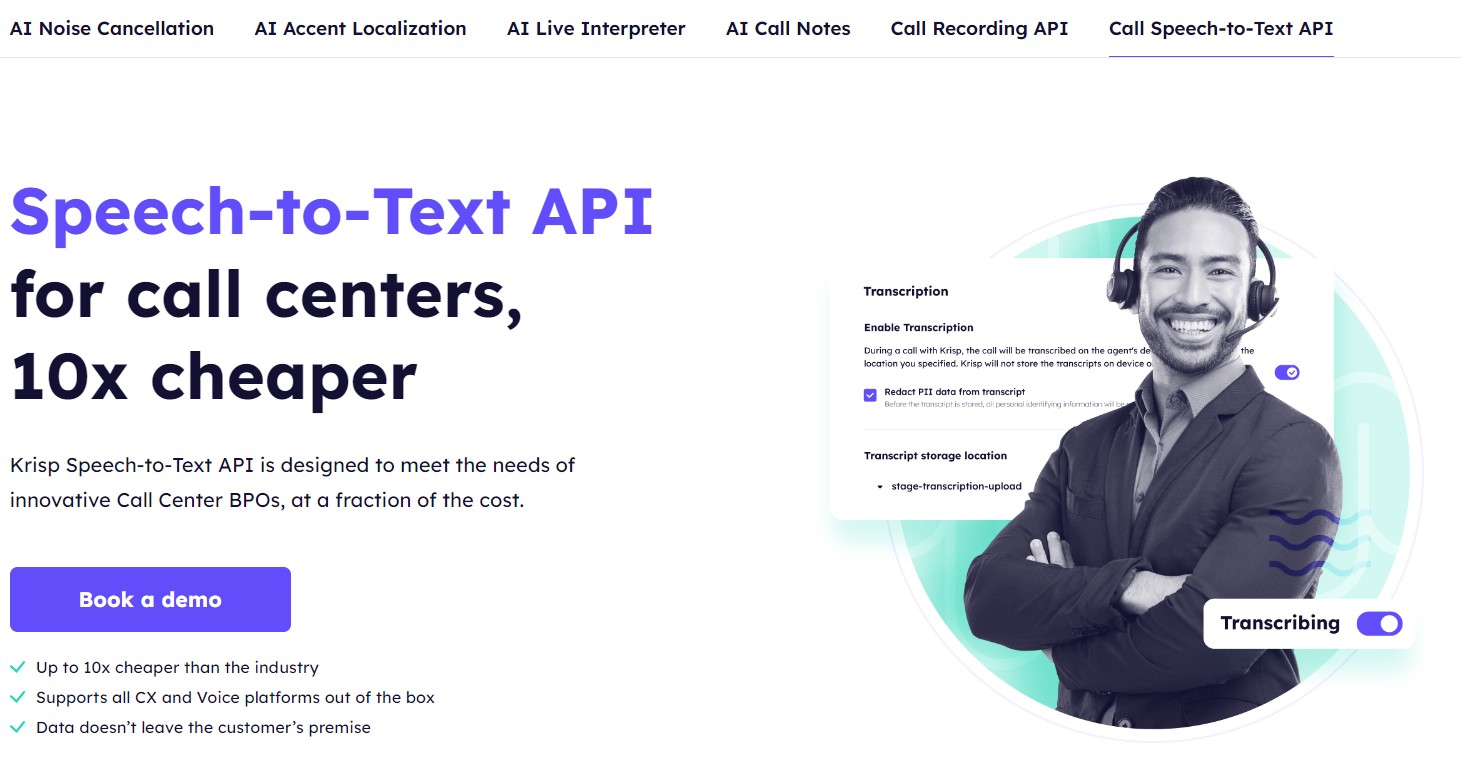In 2024, Speech-to-Text (STT) technology has solidified its role as a critical component across various industries.
From enhancing customer service experiences to enabling accessibility for people with hearing impairments, accurately transcribing spoken words into written text is more important than ever.
As the demand for efficient, accurate, and versatile Speech-to-Text solutions continues to grow, so does innovation within this field. This article delves into the most innovative speech-to-text APIs of 2024, highlighting the cutting-edge features and advancements shaping the future of voice technology.
The Innovative Role of Speech-to-Text Technology in 2024
In 2024, the rapid advancements in artificial intelligence (AI) and machine learning (ML) have propelled Speech-to-Text (STT) technology to new heights. Integrating deep learning models, natural language processing (NLP), and neural networks has significantly improved the accuracy, speed, and contextual understanding of STT systems.
These advancements have enabled Speech-to-text technology to transcribe speech with near-human accuracy and understand and interpret nuances such as tone, intent, and context, making it more versatile and reliable than ever.
Speech-to-text technology is now a cornerstone in a variety of sectors:
1. Customer service
In contact centers, STT is being used to transcribe and analyze customer interactions in real-time. This allows businesses to monitor conversations for quality assurance, extract insights from customer feedback, and automate responses, leading to improved customer satisfaction and operational efficiency.
2. Accessibility
STT technology plays a crucial role in making content accessible to individuals with hearing impairments. By converting spoken words into text, it enables real-time captioning in live events, video content, and meetings, ensuring that everyone can participate and understand the spoken information.
3. Content creation
For content creators, STT has become an invaluable tool in the transcription of interviews, podcasts, and video content. It streamlines the process of creating written content from audio and video sources, allowing creators to focus on refining their messages rather than transcribing manually.
4. Healthcare
In healthcare, STT is being used to transcribe doctor-patient interactions, which helps in maintaining accurate medical records and streamlining the documentation process. This reduces the administrative burden on healthcare professionals and ensures that patient information is recorded accurately and efficiently.
5. Education
Educational institutions are leveraging STT to provide real-time transcriptions of lectures and seminars, making learning more accessible to students who may have difficulties in understanding spoken content. This technology also supports remote learning by offering subtitles for recorded lectures, enhancing the overall learning experience.
These applications highlight the widespread impact of STT technology across multiple industries. As AI and ML continue to evolve, the potential for further innovation in STT is vast, promising even more sophisticated and context-aware solutions in the near future.
Key Criteria Defining Speech-to-Text API Innovation
In 2024, the Speech-to-Text (STT) landscape has evolved significantly, and the criteria for what makes a Speech-to-Text API “innovative” have become more sophisticated and varied. When evaluating innovation in Speech-to-Text APIs, the following key factors stand out:
1. Accuracy
- Definition: The ability of the STT API to transcribe spoken language into text with a high degree of precision, even in challenging audio conditions.
- Importance: Accuracy is paramount in applications where the transcription needs to be as close to perfect as possible, such as in legal or medical settings. Inaccurate transcriptions can lead to misunderstandings, errors in documentation, and ultimately, loss of credibility and trust.
2. Speed
- Definition: The Speech-to-Text API’s efficiency in processing audio and generating transcriptions, particularly in real-time scenarios.
- Importance: Speed is critical for applications like live streaming, customer service interactions, and real-time communication platforms. Delays in transcription can disrupt the flow of communication and negatively impact user experience. Innovative STT APIs offer low-latency solutions that keep up with fast-paced environments.
3. Multilingual support
- Definition: The capability of the Speech-to-TexAPI to accurately transcribe speech in multiple languages and dialects, catering to a global audience.
- Importance: In an increasingly globalized world, businesses must often operate across multiple languages. Multilingual support is crucial for companies looking to serve diverse markets, from customer service centers handling international clients to content creators reaching global audiences. An innovative STT API in 2024 must offer robust multilingual capabilities with consistent accuracy across languages.
4. Noise cancellation
- Definition: The ability of the Speech-to-Text technology to filter out background noise and focus on the speaker’s voice, enhancing transcription accuracy in noisy environments.
- Importance: Background noise is a common challenge in contact centers, remote workspaces, and public places. An innovative Speech-to-Text effectively reduces noise interference, ensuring that the transcription remains clear and accurate, which is essential for maintaining communication quality and ensuring accurate data capture.
5. Ease of integration
- Definition: The simplicity and flexibility with which the STT API can be integrated into various platforms, applications, and workflows.
- Importance: Ease of integration is vital for developers and businesses who want to incorporate STT technology into their existing systems with minimal disruption. An innovative Speech-to-Text API provides comprehensive documentation, SDKs, and support for various programming languages and platforms, allowing for quick and seamless integration. This flexibility enables businesses to leverage STT technology without needing extensive technical expertise or reconfiguring their systems.
How These Criteria Apply to Different Use Cases
Real-time transcription
Accuracy and speed are crucial for real-time applications such as live events, streaming, and customer service interactions. The ability to process and transcribe speech instantly without sacrificing accuracy ensures a smooth and engaging experience for users.
Enhancing customer experiences
Noise cancellation and ease of integration play significant roles in environments like contact centers, where background noise can interfere with clear communication. Integrating a noise-cancelling Speech-to-Text API seamlessly into existing CRM systems enhances the customer experience by providing clear and accurate communication, which can improve satisfaction and loyalty.
Global communication
Multilingual support is essential for businesses operating across different regions and languages. An STT API that can handle multiple languages with consistent accuracy allows companies to engage with a broader audience, offering services and content that are accessible to non-native speakers.
Industry-specific applications
In fields like healthcare or legal services, where precision is critical, accuracy is the top priority. An innovative STT API in these sectors must ensure that transcriptions are free of errors and can be trusted for official documentation and compliance purposes.
Top Innovative Speech-to-Text APIs of 2024
As the demand for accurate and efficient Speech-to-Text (STT) technology continues to rise, several STT APIs have emerged as leaders in innovation, each offering unique features and capabilities tailored to various industry needs. Below is a list of the most innovative STT APIs of 2024, showcasing both well-known providers and emerging players in the space.
1. Google Cloud Speech-to-Text
Standout features
- Real-time Processing: Google Cloud’s STT API offers near real-time transcription, making it ideal for live-streaming and instant transcription needs.
- Multi-Language Support: Supports over 125 languages and variants, enabling global reach for businesses.
- Advanced Punctuation and Formatting: Automatically adds punctuation and formatting, improving readability without manual editing.
Unique technologies
- Deep learning models: Utilizes advanced deep learning models to improve accuracy and handle complex language patterns, accents, and dialects.
Practical Applications:
- Widely used in customer service for transcribing calls, in media for subtitling, and in various industries for real-time transcription of meetings and conferences.
2. Microsoft Azure Speech
- Standout Features:
- Customizable Models: Allows users to create custom speech models tailored to specific vocabularies, industry jargon, and noise environments.
- Speech Translation: Provides real-time translation of spoken words into multiple languages, useful for global communication.
- Speaker Recognition: Can identify and differentiate between multiple speakers in a conversation, enhancing the accuracy of transcription.
- Unique Technologies:
- Azure Cognitive Services Integration: Seamlessly integrates with other Azure Cognitive Services, such as translation and sentiment analysis, for a comprehensive AI solution.
- Practical Applications:
- Ideal for multilingual customer service, content creation in different languages, and industries where speaker identification is crucial, like legal and financial services.
3. Rev AI

Standout features
- High accuracy: Known for its exceptional accuracy in transcription, even with difficult accents and low-quality audio.
- Flexible API: Offers a highly flexible API that can be easily integrated into various platforms and applications.
- Custom vocabulary: Allows users to upload custom vocabularies to improve accuracy for industry-specific terms and proper nouns.
Unique technologies
- Human-in-the-Loop System: Combines AI with human review to achieve the highest possible accuracy, especially for critical applications.
Practical applications
- Commonly used in legal transcription, media production, and education for creating precise and reliable transcripts.
4. AssemblyAI

Standout features
- End-to-End deep learning: Utilizes end-to-end deep learning models that continuously improve over time, enhancing transcription accuracy.
- Topic detection: Can detect and label different topics within a conversation, providing more context to transcriptions.
- Sentiment analysis: Integrates sentiment analysis into transcriptions, allowing users to gauge the emotional tone of conversations.
Unique technologies
- Audio intelligence API: Provides additional insights such as speaker diarization, topic detection, and sentiment analysis alongside transcriptions.
Practical applications
- Ideal for businesses that need more than just transcription, such as customer service analytics, market research, and content moderation.
5. Deepgram

Standout features
- Real-time Streaming: Offers real-time streaming with low latency, designed for fast-paced environments.
- AI-Powered Speech Recognition: Leverages cutting-edge AI to handle complex audio scenarios, including multiple speakers and noisy backgrounds.
- Custom acoustic models: Users can train custom acoustic models to match specific audio environments, improving accuracy.
Unique technologies:
- End-to-End speech stack: Utilizes an end-to-end speech stack that optimizes every stage of speech processing for better performance and accuracy.
Practical applications
- Used in industries such as telecommunication, media, and financial services where real-time and highly accurate transcription is essential.
6. Krisp Speech-to-Text API
Standout features:
- Noise cancellation: Incorporates Krisp’s industry-leading noise cancellation technology, ensuring high transcription accuracy even in noisy environments.
- Real-time transcription: Offers real-time transcription capabilities, making it perfect for live conversations and events.
- Low latency: Optimized for low latency, providing quick and responsive transcriptions in real-time applications.
Unique technologies:
- AI-Powered Noise Filtering: Uses advanced AI to filter out background noise, ensuring that only the speaker’s voice is captured and transcribed.
Practical applications
- Particularly beneficial for contact centers, remote work environments, and any situation where background noise could interfere with transcription quality.

In Sum
In 2024, Speech-to-Text APIs have become indispensable tools across various industries, offering innovative features tailored to specific needs. From real-time transcription to advanced noise cancellation and multilingual support, the STT solutions highlighted in this article demonstrate the cutting-edge capabilities driving the future of voice technology.
Whether you’re in customer service, healthcare, or content creation, selecting the right STT API can significantly enhance your operations. As technology evolves, these APIs will remain at the forefront, empowering businesses to communicate more effectively and efficiently in an increasingly digital world.
Frequently Asked Questions

